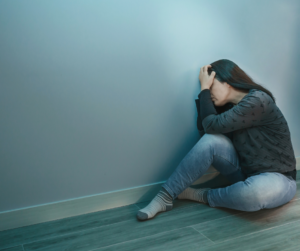
What Are Anxiety Disorders?
Anxiety is a normal reaction to stress and can be beneficial in some situations. It can alert us to dangers and help us prepare and pay attention.
Anxiety Disorders differ from normal feelings of nervousness or anxiousness and involve excessive fear or anxiety. Anxiety disorders are the most common of mental health disorders and affect nearly 30 percent of adults at some point in their lives.
Anxiety Disorders are treatable and a number of effective treatments are available. The most clinically validated is CBT Therapy. A course of 8-12 sessions of CBT Therapy helps most people lead normal and productive lives.
How Anxious are You?
Are you living with high levels of anxiety? Take our simple and quick test to see how severe your anxiety is.
Panic Attacks/ Panic Disorder
The core symptom of panic disorder is recurrent panic attacks, an overwhelming combination of physical and psychological distress. During an attack several of these symptoms occur in combination:
- Palpitations, pounding heart or rapid heart rate
- Sweating
- Trembling or shaking
- Feeling of shortness of breath or smothering sensations
- Chest pain
- Feeling dizzy, light-headed or faint
- Feeling of choking
- Numbness or tingling
- Chills or hot flashes
- Nausea or abdominal pains
- Feeling detached
- Fear of losing control
- Fear of dying
Because symptoms are so severe, many people who experience a panic attack may believe they are having a heart attack or other life-threatening illness and may go to a hospital ER. Panic attacks may be expected, such as a response to a feared object, or unexpected, apparently occurring for no reason. The mean age for the onset of panic disorder is 22-23. Panic attacks may occur with other mental disorders such as depression or PTSD.

Generalised Anxiety Disorder (GAD)
Generalised anxiety disorder involves persistent and excessive worry that interferes with daily activities. This ongoing worry and tension may be accompanied by physical symptoms, such as restlessness, feeling on edge or easily fatigued, difficulty concentrating, muscle tension or problems sleeping. Often the worries focus on everyday things such as job responsibilities, family health or minor matters such as chores, car repairs, or appointments.
Phobias, Specific Phobia
A specific phobia is excessive and persistent fear of a specific object, situation or activity that is generally not harmful. Patients know their fear is excessive, but they can’t overcome it. These fears cause such distress that some people go to extreme lengths to avoid what they fear. Examples are fear of flying or fear of spiders.
Agoraphobia:
Agoraphobia is the fear of being in situations where escape may be difficult or embarrassing, or help might not be available in the event of panic symptoms. The fear is out of proportion to the actual situation and lasts generally six months or more and causes problems in functioning. A person with agoraphobia experiences this fear in two or more of the following situations:
- Using public transportation
- Being in open spaces
- Being in enclosed places
- Standing in line or being in a crowd
- Being outside the home alone
The individual actively avoids the situation, requires a companion or endures intense fear or anxiety. Untreated agoraphobia can become so serious that a person may be unable to leave the house. A person can only be diagnosed with agoraphobia if the fear is intensely upsetting, or if it significantly interferes with normal daily activities.
Social Anxiety Disorder (previously called social phobia)
A person with social anxiety disorder has significant anxiety and discomfort about being embarrassed, humiliated, rejected or looked down on in social interactions. People with this disorder will try to avoid the situation or endure it with great anxiety. Common examples are extreme fear of public speaking, meeting new people or eating/drinking in public. The fear or anxiety causes problems with daily functioning and lasts at least six months.
Health Anxiety (Hypochondriasis)
It’s possible you have health anxiety if you spend excessive time worrying about if you are ill. Or find yourself constantly fearful about getting ill. Signs you may have Health Anxiety are:
- Constant and repetitive worry that your GP has missed something,
- Constantly checking your body for signs of illness / anomalies.
- Excessively worrying about your health,
- Frequently asking partners/family/ friends for reassurance that you are ok and healthy.
- Spending a lot of time looking at health information on the Internet. Searching for symptoms/ information on Google. Or on Television/ Newspapers
- Behaving as if you were ill/ going to die
Anxiety symptoms like headaches or a increased heart rate are often mis-interpreted by someone with Health Anxiety as definitive signs of illness.
Obsessive – Compulsive Disorder (OCD)
People who suffer with OCD have obsessions, compulsions or both
- What is an Obsession? An obsession is defined as an intrusive thought or image that you keep thinking/obsessing about. Such intrusions are distressing and unwelcome and for the most part are out of our control. It can be really difficult/ almost impossible to ignore or not believe them when they arise in our minds.
- What is a Compulsion? A compulsion is something you do repeatedly to relieve the anxiety created by the “obsession”. Compulsions can be “internal” ,done inside of our heads, ie repeating a word/ phrase to reduce our anxiety/ fear. Or they can be external ie. checking that the front door is locked 20 times.
Often people with OCD believe that if they don’t do the compulsions then something bad will happen, either to themselves or to someone else. It is common for people with OCD to realise that their thinking and behaviour is not logical/ rational but still they can find it very difficult to stop.
How Common Are Anxiety Disorders?
In any given year the estimated percentage of U.K. adults with various anxiety disorders are:
- 7 to 9 percent: specific phobia
- 7 percent: social anxiety disorder
- 2 to 3 percent: panic disorder
- 2 percent: agoraphobia
- 2 percent: generalized anxiety disorder
- 1 to 2 percent: separation anxiety disorder
Women are more likely than men to experience anxiety disorders.

Diagnosis and Treatment of Anxiety
The first step is to see your doctor to make sure there is no physical problem causing the symptoms. If an anxiety disorder is diagnosed, a mental health professional can work with you on the best treatment. Unfortunately, many people with anxiety disorders don’t seek help. They don’t realise that they have an illness that has effective treatments.
Although each anxiety disorder has unique characteristics, most respond well to two types of treatment: psychotherapy, or “talking therapy,” and medications. These treatments can be given alone or in combination. Cognitive Behaviour Therapy (CBT), a type of talking therapy, can help a person learn a different way of thinking, reacting and behaving to help feel less anxious.
Medications will not cure anxiety disorders but can give significant relief from symptoms. The most commonly used medications are anti-anxiety medications (generally prescribed only for a short period of time) and antidepressants. Beta-blockers, used for heart conditions, are sometimes used to control physical symptoms of anxiety.
Separation Anxiety Disorder:
A person with separation anxiety disorder is excessively fearful or anxious about separation from those with whom he or she is attached. The feeling is beyond what is appropriate for the person’s age, persists (at least four weeks in children and six months in adults) and causes problems functioning. A person with separation anxiety disorder may be persistently worried about losing the person closest to him or her, may be reluctant or refuse to go out or sleep away from home or without that person, or may experience nightmares about separation. Physical symptoms of distress often develop in childhood, but symptoms can carry through adulthood.
Self-Help, Coping, and Managing Anxiety:
There are a number of things people do to help cope with symptoms of anxiety disorders and make treatment more effective. Stress management techniques and Meditation can be helpful. Support groups (in-person or online) can provide an opportunity to share experiences and coping strategies. Learning more about the specifics of a disorder and helping family and friends to understand better can also be helpful. Avoid caffeine, which can worsen symptoms, and check with your doctor about any medications.
Risk Factors for Anxiety:
The causes of anxiety disorders are currently unknown but likely involve a combination of factors including genetic, environmental, psychological and developmental. Anxiety disorders can run in families, suggesting that a combination of genes and environmental stresses can produce the disorders.
Related Conditions
- Post Traumatic Stress Disorder (PTSD)
- Acute stress disorder
- Obsessive-compulsive disorder
- Adjustment disorder
- Health Anxiety
- Body Dysmorphic Disorder (BDD)
CBT Therapy London
Cognitive Behavioural Therapy (CBT Therapy), Mindfulness Meditation and Medication can all be used to treat anxiety disorders. We’ll tailor a plan to your circumstances, medical history, and underlying conditions to help you live a balanced life free of anxiety.
The CBT Clinic London understands anxiety and can help. After assessing your symptoms, medical history, and severity of your anxiety, we can create a treatment plan and help you live your life to the full again.
Getting help is easy. Simply complete our new patient registration form or if you have questions, contact our friendly team who will assist you. You can call us on 0207 157 9924 or Book Online. Consultations are free and will reveal your diagnosis and enable us to create a customised treatment plan.

